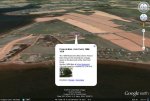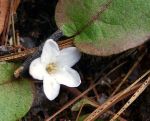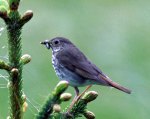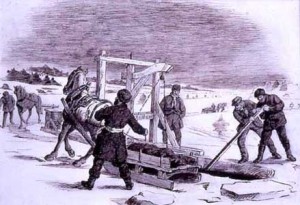While other farmers readied the plow and burnt brush on new clearings, Francis Bain spent most of his April days in the woods and on the shore writing about the first migratory bird sightings. Today we usually think of nature observation as an activity for public space, but Bain would not have understood the delineations between public land and the rest of nature. This man had full range of his environment, going out in every direction at every time of day. When he heard a bird he “went in pursuit of him.” There is never a sense in the journals that the landscape was too crowded to wander or too limited for wildlife, even though York Point was being extensively cleared and resettled for agriculture.
Most of these spring observations were made on his own property, although on the 16th he walked to “the Indian camps in a glade in the woods,” which was presumably at Rocky Point, across the West River from his home. He notes several familiar places on his property, including “the cove,” “the maple grove near the swamp,” “the poplars at our window,” “the orchard,” the “garden walks,” the “crops,” the “back place” (a site which they stumped in July 1879), and “the mussel bed” with its “excavations” made from digging mussel mud and other sea manures.
1879
York Point, Prince Edward Island — Francis Bain
May 1, The weather is now turned beautifully warm and summer-like. The Gulf is said to be clear of ice and summer’s glad smile has suddenly burst in beauty on the broken reign of winter. A thunder cloud spread its dark mass up from the south western sky this afternoon and drenched the fields with heavy pours of rain. The grass is greener one day after.
May flowers are in bloom. How marvelous that chemistry which converts the first flashes of summer light into such wondrous sweetness of fragrance and of bloom. The Wood Robin is singing his plaintive melody, and the Linnet laughing half his song. The Golden Wood Pecker calls loudly for his mate or raps the hollow ramphole and the blue-finch and chip sparrow give quiet ditties from the hedge and meadow. Frogs are in full blast at night.
April 24, A strong cold, icy wind from the north, scattering squalls of snow at interval is retarding the advance of spring to day. The sky is dark and angry and the newly released waves lashed into fury by the strong wind.
The singing of the birds is nearly hushed to day; even the crows scarcely caw. Small flocks of geese sweep fast born on the wild wing of the storm.
I observe that nearly all of the smaller stones on the shore, lying at a short distance from the bank, are reduced by the action of the winter’s frost. This is much more than could have been accomplished in the same period by the waves. Many large stones farther out are broken to pieces by the weight of ice resting on them. I observed a dead flat fish (Sole) a foot long by 7 or 8 inches broad.
April 22, The ice broke up in the harbour to day and a large part of it went out.
April 20, Lovely visions of spring appear ever and anon as you wander abroad among the woods and fields. There is the Robin’s cherry laugh and his gay flight above the tree tops. The sweet little song of the Sparrow from some sheltered sunny spray that gives a tender touch of sweetness to the calm sunshine of the balmy scene. Quiet woody glades where last year’s wilted verdure carpets the scene and every withered plant is trod low ‘neith the cruel foot of wintery adversity; but the grand forms of the forest monarchs stand around and display their naked beauty of outline against the clear, deep circular of the cloudless sky. And the breeze that flows among their tops whispers soft vernal musick that draws the soul into sympathy with nature, while the glowing sunlight that flashes from a thousand polished sprays pours over us an intensity of warmth that speaks of returning life.
The broad stream of the river just throwing off its wintery cloak and baring its deep, clear blue bosom to the play of the breeze and the flash of the sunlight; its lines of ducks, its clouds of geese and brent and solitary gulls with snow white pinion. Then there are little pictures of sand reaches along the shore sadly disfigured by frost and grounding ice but the feet of the silvery waves are fast smoothing them over. With what fresh joy we welcome very feature of the scene! The level rippled sand, the rocky skerries clothed with their weeds, the groups of white wasted shells, each little denizen of the pools – Shrimps, Periwinkle, Salitrus, young Natica trailing his big foot along, the Nassa gone far out to the deep and scarcely to be found, and the Purpuria securely hid ‘neith the projecting edge of beetling rock.
April 15, I saw a flock of 100 Robins arrive this morning. They came from the N. East and were probably moving about in social combination before dispersing on their summer’s feeding ground. Solitary individuals had been seen a week ago. We have numbers of Song sparrows and Blue Birds, Cranes, and Golden Eyes.
1866
York Point, Prince Edward Island — Francis Bain
May 2, At Ten O’Clock in the evening, an inch of snow lay on the ground.
April 28, Saw a crow fly 540 yards per minute. The head of the hen chickadee is now dark brown and her sides red brown.
The whole aspect of the plumage by this change is richer and more pleasing. Saw many flowers (Epigaea repens) in bloom
April 27, The calm silvery tide was rapidly filling up the cove this evening as a group of noisy crows rested on the fence and bushes on its western side preparing to start home for the night. When they had all left in small detachments, I observed one old sentinel still remain in his commanding post silently, but apparently not wishing to watch when all his care had gone, and wanting to determine whether they had or no, he leaped to the highest bough of the tree, looked around, and several times sounded vigorously the cry of alarm. No one responded to it; this duty was done and he sped off homeward too. By admeasurement, I found that he flew at the rate of 500 yards in one minute.
April 24, Heard the whistling sparrow. Saw a bee coursing joyously through the free air of the open field yesterday. The alders of the brooks and swamps are hung with a profusion of brown silky catkins. They cover the shrubby vegetation like a veil spread along the dark hollows.
April 22, This evening about sunset I heard the “cong” beginning his cry. I went in pursuit of him, and found a small owl, about the size of a Robin, brown above and ash marked with brown and black below. It sat upon a secluded limb about eight feet from the ground, and accompanied each note with a motion of the body. When near to it its call sounded cook, cook, cook, but as it reverberated through the rigid stems of the leafless forest it appears of a harder tone and more lengthened.
I saw a toad making his way over the stones and sand up from the salt water. Saw a crow seize a large toad and fly off with him in his bill. He lit and proceeded to discuss him for a meal.
April 21, Heard the sweet melodious plaintive love-song of the Hermit Thrush.
April 20, This morning at sunrise a Linnet, the first of the season, poured fourth his full rapturous, joyous strain of melody from the poplars at our window. Heard a wood-cock (Golden-winged wood pecker).
April 16th, This evening I stood by the Indian camps in a glade in the woods. The death like stillness of night rested on the gloomy forest; through the opening, surrounded by the wreathed and pinnacled tops of the trees, calmly looked the golden crescent of the new moon, accompanied by her glittering phalanx of stars. A holy, reverential, solemn calm rested on the soul while quietly contemplating this scene, and the effect was heightened by the measured beat of the Saw-whether’s plaintive bell.
April 15, Snow Buntings seen? Perhaps a Meadow Pipit.
April 14, Frogs were heard today.
April 13, Shot a Song Sparrow. Its crop contained insects, mostly brown dung beetles, and a few seeds of Conicus discolour. Its colours light ash, marked with brown and black under, and brown varied with ash and black above. No trace of yellow marked its head.
Grass is springing on the sunny side of bushes.
April 12, Saw a butterfly with brown and golden edged wings. Heard the hoarse croak of brant resound through the still night air. The flock was evidently a large one. Blue birds and Song Sparrows seen as numerous as in summer, but Robins are scarce.
April 11, Robins were singing this morning. The day is delightfully clear and warm; the groves are vocal with the early songsters.
April 10, Flocks of geese going north east. Observed none going in any other direction.
April 8, Saw a flock of Snow Buntings flying and whirling over the meadows and light on their surface.
April 7, This morning as the clouds steeped in the ruby light of sunrise rolled softly from the east, a solitary robin sounded and energetically its clear flocking call and softer chuck, chuck from the topmost boughs of our grove. By its energetic deportment and constant and vigorous calling it seemed distressed with its solitude and was seeking to awake a response in some kindred bosom by its cries.
Saw a Song Sparrow this morning sit and sing by the maple grove near the swamp where I saw the first one last year. A flock of Snow Buntings flew swiftly high in the air over our place. A couple of small flocks of geese went north east and one south west. A whole flock of Robins were seen today. Flocks of Blue Birds must have arrived too, for their soft twitter is everywhere heard through the woods.
April 6, A Blackbird (Y. merula) was flying about the fields and groves in the calmy misty warm morning air, sounding its distinct unmistakable “chuck, chuck, swe-eet.” Saw a Blue Bird sitting on a lofty bough of a beech, looking about it on the warming landscape and twitting its soft melody complacently to its summer haunts.
Yesterday I saw four geese going to the south west and large flocks going to the north east. This forenoon four flocks comprising ninety geese went to the north east. Saw two Cranes in the dusky sky of evening pursuing their powerful, steady flight in close company down the river. This bird called Crane is the “Blue Heron” (Ardea herodias).
April 4, Flocks of ducks and gulls in the Elliot [West River]. Yesterday while the wind was north, I observed a flock of wild geese heading toward the north east while a flock of crows were going in the same direction. The crows flew much faster than the geese and lost no lee way in their course, while the latter only succeeded in making an easterly direction.



